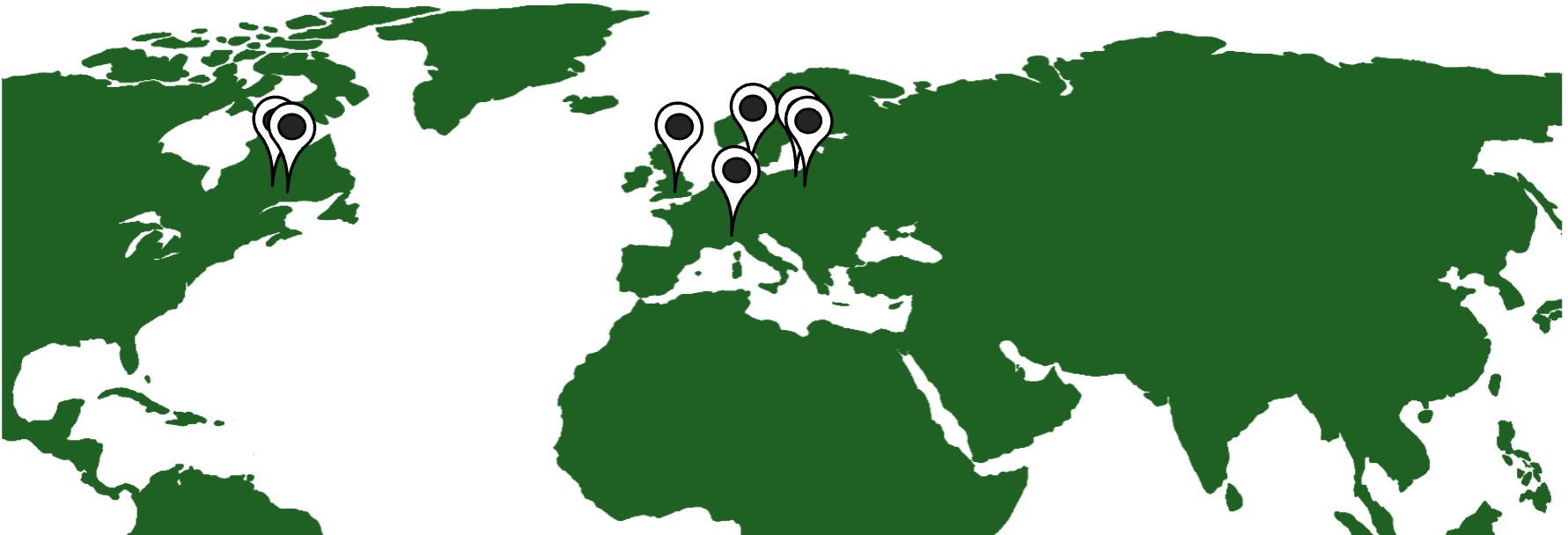Research Areas
LegumeLegacy Multisite Experiment

LegumeLegacy Multisite Experiment

Common crop rotation experiment:
LegumeLegacy is implementing a common multi-site crop rotation experiment across seven sites. We seek to address how manipulating species diveristy in a grassland ley affects both the ley outcomes and a follow-on crop. We will test genotpye by environment interactions across sites, and the impact of environmental and management manipulations at individual sites.
Site details
The site numbers here follow on from the numbering scheme used to number LegacyNet sites (reflecting the parallels in the experimental designs between the LegacyNet and LegumeLegacy experiments).
| Unique site ID* | Country | Site Location | Establishment date | Grasses | Legumes | Herbs | Follow on species |
|---|---|---|---|---|---|---|---|
| CA3 | Canada | Saint-Augustin | June 2022 | Bromus inermis Phleum pratense | Trifolium repens Trifolium pratense | Cichorium intybus Plantago lanceolata | Cereal |
| CA4 | Canada | Normandin | May 2022 | Bromus inermis Phleum pratense | Trifolium repens Trifolium pratense | Cichorium intybus Plantago lanceolata | Cereal |
| CA5 | Canada | Saint-Augustin | June 2023 | Bromus inermis Phleum pratense | Trifolium repens Trifolium pratense | Cichorium intybus Plantago lanceolata | Cereal |
| CH2 | Switzerland | Agroscope | Apr 2023 | Lolium perenne Phleum pratense | Trifolium repens Trifolium pratense | Cichorium intybus Plantago lanceolata | Cereal |
| DK2 | Denmark | Aarhus University | Apr 2023 | Lolium perenne Phleum pratense | Trifolium repens Trifolium pratense | Cichorium intybus Plantago lanceolata | Cereal |
| PL2 | Poland | PULS | Apr 2023 | Lolium perenne Phleum pratense | Trifolium repens Trifolium pratense | Cichorium intybus Plantago lanceolata | Cereal |
| PL3 | Poland | Danko | Oct 2022; Sep 2023 | Lolium perenne Phleum pratense | Trifolium repens Trifolium pratense | Cichorium intybus Plantago lanceolata | Cereal |
| UK2 | United Kingdom (England) | Reading | Apr 2023 | Lolium perenne Phleum pratense | Trifolium repens Trifolium pratense | Cichorium intybus Plantago lanceolata | Cereal |
Work Package 1
Data Science, Statistical Technology and Genetics

Data Science, Statistical Technology and Genetics
Objectives:
To develop and apply new statistical methods, and breeding and molecular genetics techniques to collectively improve sustainable agriculture on a local scale.
Projects:
- Development and application of multivariate statistical modelling tools for assessing management strategies in the LegumeLegacy multi-site crop rotation experiments, and integration with LegacyNet.
- Modelling the impact of genotype by environment interactions in the LegumeLegacy multi-site crop rotation experiments, and integration with LegacyNet.
- The dry matter yield and, quality of wheat produced as a follow-on crop from a range of multispecies swards with differing nitrogen inputs.
- Development of species composition and genetic diversity in multispecies swards.
Work Package 2
Products and quality

Products and quality
Objectives:
Determine the impact of the species composition in legume-based grassland leys on the grassland yields and benefits via legacy effects on a subsequent cereal. Using a combination of a range of sites with different climates and controlled manipulation of environmental and management parameters, understand factors affecting yield, yield stability and legacy effects in crop rotations.
Projects:
- The effect of selected management factors on grassland leys and follow-on crops.
- Effects of ley composition on cereal grain quality / potential of cultivar choice to improve mixture composition and heat stress tolerance.
- Trajectories in plant species and community traits composition, and depth of nitrogen inputs to the soil.
- Quantifying nutrient dynamics in diverse forages for animals and environmental performance
Work Package 3
Environment and Whole System Analysis

Environment and Whole System Analysis
Objectives:
Link the yield potential to the product quality and environmental performance of grassland mixtures within crop rotation systems to advance sustainable agriculture.
Projects:
- Benefits of the species composition in grassland leys for the nitrogen cycle and weed suppression across the crop rotations.
- Impact of a maximised niche utilisation above- and below ground on weed suppression, carbon sequestration and nitrogen use efficiency.
- The effect of species mixtures on below ground biodiversity: direct and legacy effect.
